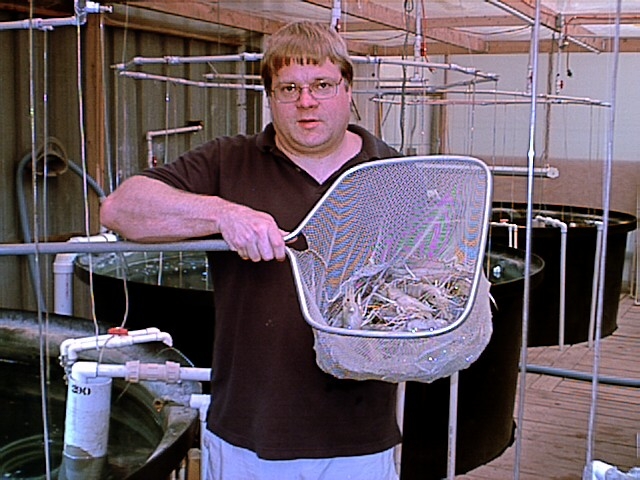
Features
Breeding
Business Management
Texas hatchery succeeds with help from tiny species
October 2, 2020 By Julia Hollister
 Craig Upstrom, Aquaculture of Texas
Craig Upstrom, Aquaculture of Texas Craig Upstrom knew he was on to something big when he joined Aquaculture of Texas’ revolutionary shrimp hatchery. And wait, there’s more.
It is the only hatchery in the Western World to produce all male shrimp that Upstrom copyrighted as ‘ZZ Males’.
The company, located west of Fort Worth, Texas, was formed by six investors in 1986 as a Sub-s Corporation, It has stock holders but is not traded on Wall Street and is not a public company. Upstrom started out as a worker in late 1986 and over the years was able to buy enough stock to gain control of the company. He owns more than 51 percent of the stock and is currently the company’s president.
“It is a year-round hatchery of post-larvae and juveniles of Macrobrachium rosenbergii that ships 125 million shrimp a year,” he says. “I do about 10 larvae runs a year, it takes 33 days to complete a larvae cycle. I sell the post-larvae or I nurse them to a 30, 45, or 60-day juvenile shrimp and sell them.”
Freshwater prawns are a tropical species, and require warm water to survive. Because of this, all the nursery and hatchery work must be done indoors in the U.S. All the grow-out is done by farms with ponds. A correctly engineered, constructed and well-managed pond will result in a predictable harvest of about 1,000 to 1,200 pounds/acre of a large, highly valuable 10 count/lb. whole shrimp. In tanks, the farms use a high protein sinking feed and the shrimp feed at least twice a day: morning and evening.
Upstrom developed the nursery techniques that are now widely used around the world. Representatives from Brazil, Trinidad, Greece, Japan and others have come to learn from him.
Hatching goes on year-round. In the spring, the shrimp harvest are delivered to the U.S. market, while the rest of the year is designated for exporting. The business was not exempted from the effects of COVID-19 as several customers reduced their orders due to September’s closed marketing venues.
Aquaponic potential
Another shrimp market for Aquaculture of Texas is the aquarium market, making it an unusual and perfect choice for a home hobby. Prawns can be an interesting and unique addition to your tank, says Upstrom. A wide range of different sized shrimp are available throughout the year from Aquaculture of Texas for the aquarium market.
“Freshwater prawns will make a unique addition and increase the efficiency of your aquaponics system,” Upstrom says. “They are hardy, easy to grow and a highly valued product.”
These prawns consume waste of any kind, thereby helping to break down and convert organic matter into material that can be used by plants. They also eat snails and can be used to control or eliminate them in aquatic systems.
Tropical freshwater prawns will survive water temperatures between 57°F and 105°F, with the optimum temperature range being 78°F to 88°F. While freshwater prawns live as long as three years, you can begin to harvest large prawns as early as six months of age.
Juvenile prawns can be incorporated into different grow-out system, and will take approximately four months to mature to harvest size in an aquaponics system, Upstrom says.
“As these juvenile prawns grow, their requirements for space also increase: large prawns weighing 2oz. will have a body length of seven inches, and will require one to two square feet of space,” he says. Juvenile prawns can be purchased at $75 per 400 animals.
The larvae feed 12 to 14 hours a day and must be fed every hour. Every spring, Upstrom hauls the juvenile shrimp to the farms. In addition to commercial farms, the hatchery also works with Trophy Bass farms, hydroponic facilities, schools and universities, medical research and environmental testing labs.
To defray or even eliminate the high costs of shipping, the regional nursery concept developed by Aquaculture of Texas for commercial prawn farming can be adapted to supply regional aquaponics operations and their customers on a year-round basis.
“For this reason, we encourage aquaponics professionals to set up a small, independent nursery that can be used to supply their own needs as well as the needs of other aquaponics operations in their region,” Upstrom says. “Small 100 to 500 gallon, inexpensive systems can be used to nurse 2,000 to 10,000 post larvae prawn to a juvenile size using aquarium filters, heaters and air pumps.”
So as not to exceed the recommended density of 20 animals per square foot, a simple substrate made of PVC pipe and multiple layers of bird netting is placed in the tank to provide sufficient habitable surface area.
Becoming a regional nursery also presents income opportunities for owners of aquaponics systems, Upstrom says. Post larval prawns are less expensive than juvenile prawns, and can be shipped at a much lower unit cost. Because a large number of animals can be nursed in systems as small as 100 gallons, a nursery can inexpensively produce and distribute juvenile prawns within an area.
Print this page





